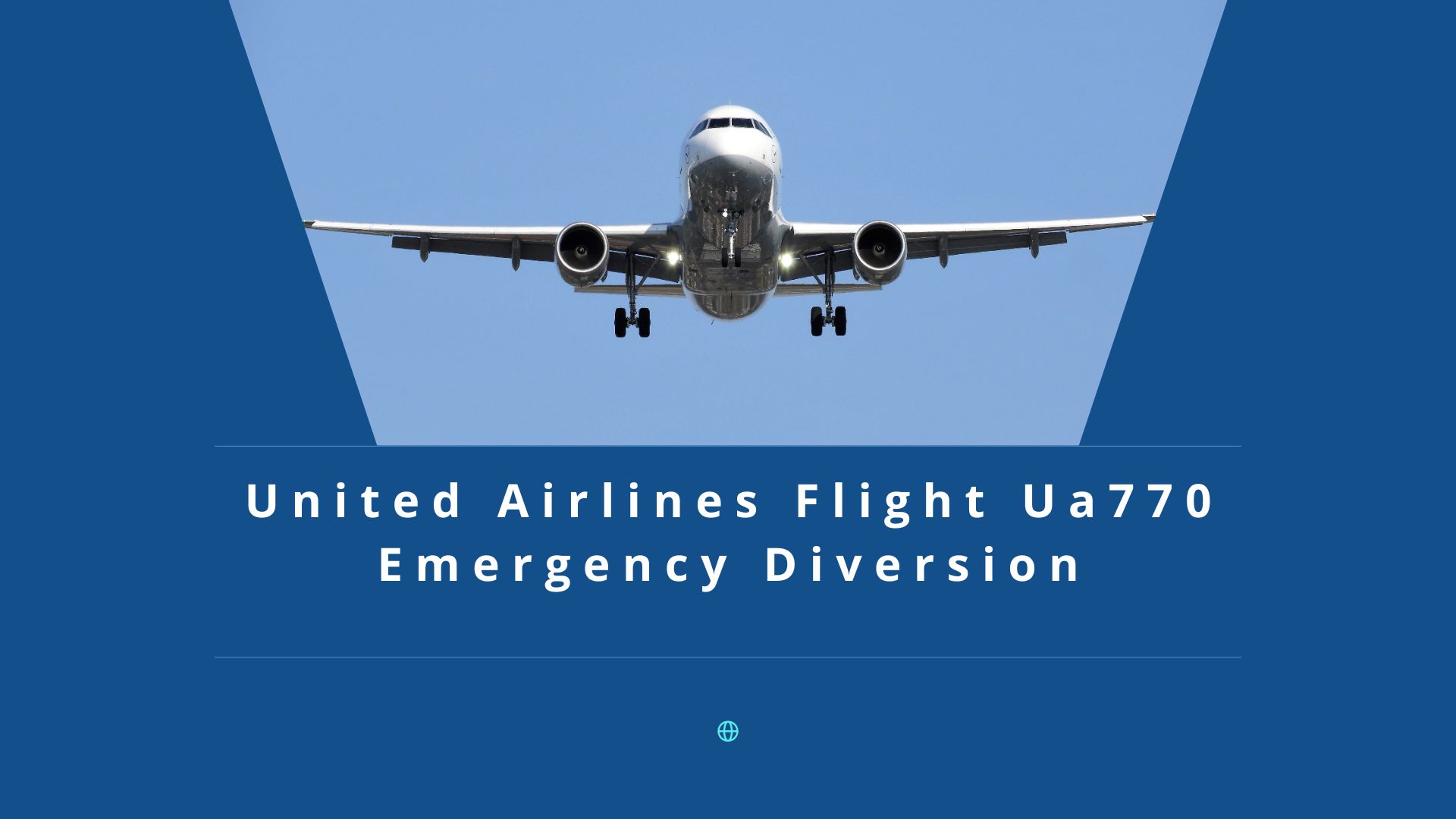Introduction
Ever boarded a flight and wondered what would happen if things took an unexpected turn? That’s exactly what passengers on United Airlines Flight UA770 experienced. An ordinary journey quickly turned into a nerve-wracking situation when the flight had to make an emergency diversion. This wasn’t just a minor delay — it was a real-time aviation incident that demanded swift action, expert coordination, and nerves of steel.
So what exactly happened with UA770? Buckle up — we’re diving into all the details.
Overview of Flight UA770
Flight Route and Details
United Airlines Flight UA770 was scheduled to fly from San Francisco International Airport (SFO) to Washington Dulles International Airport (IAD) — a transcontinental route that typically spans over five hours.
Aircraft Type and Configuration
The aircraft operating UA770 was a Boeing 757-200, a narrow-body jet known for long-haul domestic flights. It typically seats around 169 passengers in a two-class layout.
Number of Passengers and Crew Onboard
Reports indicate that 154 passengers and 6 crew members were onboard at the time of the incident.
Timeline of the Emergency Diversion
Departure Details
Flight UA770 took off on time from San Francisco around 08:15 AM (PDT). The initial leg of the flight was routine — cruising at altitude and operating normally.
When Things Went Wrong
Approximately 2.5 hours into the flight, pilots noticed anomalies in the hydraulic system — a red flag that something wasn’t right. Safety protocols kicked in immediately.
Communication with Air Traffic Control
The crew promptly contacted air traffic control, declaring a precautionary emergency. They were granted priority clearance for landing.
Emergency Landing Location and Time
The flight diverted to Denver International Airport (DEN), touching down safely around 11:20 AM (MDT) — roughly 40 minutes after the issue was detected.
Reasons Behind the Diversion
Mechanical Malfunction
Preliminary statements suggest a hydraulic system malfunction. This system powers key flight controls like brakes and flaps — so any failure is a major safety concern.
Health Emergency Possibility
Although initial speculation suggested a medical emergency, this was quickly ruled out by airline officials.
Weather Complications
Weather was ruled out as a contributing factor — skies were clear, and the Denver region was experiencing calm conditions.
Speculations vs. Confirmed Reports
Social media ran wild with theories, but United Airlines confirmed the issue was strictly mechanical and not security-related.
Passenger Experience During the Incident
In-Flight Announcements
Flight attendants kept passengers informed, though tension was undeniable. The pilot’s calm voice reassured everyone that the landing was precautionary.
Cabin Crew Response
Crew members were praised for their professionalism and poise — securing the cabin, calming nerves, and preparing passengers for landing.
Reactions from Passengers
Some passengers described the experience as “nerve-wracking but smooth.” Others expressed gratitude for the early diversion and safety focus.
Post-Landing Procedures
After landing, the aircraft was towed to a remote gate. Emergency personnel conducted checks before passengers disembarked calmly.
Response from United Airlines
Official Statements
United issued a statement confirming the diversion was “out of an abundance of caution due to a mechanical indicator.” No injuries were reported.
Customer Support Measures
Passengers were rebooked on later flights, and the airline provided meal vouchers and accommodation for those delayed overnight.
Rebooking and Compensation
Some affected travelers also received travel credits as goodwill gestures from the airline.
Airport and Emergency Services Involvement
Ground Crew Coordination
Denver’s ground teams mobilized quickly, clearing a path for the incoming emergency aircraft and ensuring safety on arrival.
Emergency Medical and Fire Services
Fire crews were stationed nearby as a precaution. No medical intervention was needed.
Airport Communication with Media and Families
Denver International issued brief alerts on their social channels, assuring the public that the situation was under control.
Media Coverage and Public Reaction
Social Media Reports from Passengers
Several passengers tweeted real-time updates, with photos of fire trucks waiting on the tarmac — fueling both panic and interest.
News Coverage Highlights
Major outlets picked up the story, emphasizing the crew’s quick thinking and the aircraft’s safe landing.
Public Concerns About Flight Safety
While some people questioned the aircraft model’s reliability, most agreed that the airline handled the situation well.
FAA and NTSB Involvement
Initial Investigations
The Federal Aviation Administration (FAA) launched a routine investigation into the cause.
Black Box and Voice Recorder Retrieval
Since no crash or impact occurred, black box retrieval was not necessary, but logs were reviewed.
Expected Investigation Timeline
Findings typically take 30–90 days, but preliminary reports often surface within weeks.
Aviation Safety Protocols During Diversions
What Triggers a Diversion?
From tech glitches to passenger illnesses, any risk to safety can trigger a diversion. Pilots are trained to make judgment calls fast.
How Airlines Are Trained for This
Every airline, including United, routinely trains staff for emergency scenarios like UA770’s — ensuring composure and control.
The Role of Pilots and Crew
Pilots follow strict checklists, while crew members ensure passenger safety — making them the unsung heroes of aviation.
Similar Past Incidents
Other United Diversions in Recent Years
UA770 isn’t the first — United has seen diversions due to engine warning lights, odor in the cabin, and sudden illness before.
Industry-Wide Emergency Trends
Such events are rare, but safety-first culture means diversions are increasing — for all the right reasons.
Lessons Learned
Every incident helps refine protocols, ensuring the next flight is even safer.
Impact on Future Flights
Inspection of Similar Aircraft
The FAA may advise extra checks on similar Boeing 757s, especially for hydraulic systems.
Review of Operational Protocols
Airlines often update internal procedures post-incident — refining response times and passenger communication.
Passenger Confidence Recovery
Most passengers bounce back quickly — trusting that modern aviation remains one of the safest ways to travel.
Safety in Modern Aviation
How Safe Are We Really?
Statistically speaking, flying is safer than ever. The chances of dying in a commercial plane crash are 1 in 11 million.
Comparing Risk Across Transportation Modes
You’re more likely to get hurt in a car accident than in a plane emergency.
Technological Improvements in Monitoring Systems
New systems detect issues long before they become catastrophic — giving pilots and engineers more power than ever.
Conclusion
Flight UA770’s emergency diversion was a reminder that while flying is incredibly safe, things can still go sideways. But when they do, training, teamwork, and technology step in to keep everyone secure. Thanks to the quick actions of the pilots and crew, what could have been a disaster became a calm, controlled landing.
Whether you’re a frequent flyer or an occasional traveler, incidents like these show just how much effort goes into keeping skies safe. And honestly? That should give all of us peace of mind.
FAQs
Q1: What caused the emergency diversion on UA770?
A suspected hydraulic system malfunction prompted the crew to land early as a precaution.
Q2: Was anyone injured during the flight?
No, all passengers and crew landed safely, and no injuries were reported.
Q3: What happens after a flight is diverted?
Passengers are typically rebooked, and airlines may offer compensation or accommodations.
Q4: Are emergency diversions common?
They are not common, but they’re more frequent than crashes — and are part of safety-first protocols.
Q5: Will passengers be compensated?
Yes, United reportedly offered meal vouchers, hotel stays, and in some cases, travel credits.

